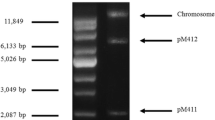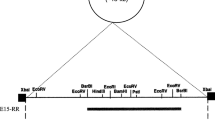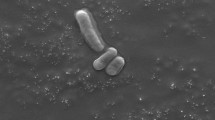Abstract
A cryptic 10.0-kb plasmid pG6303 from a multiplasmid-containing Lactobacillus plantarum G63 was studied. The analysis of replicon was facilitated by the construction of shuttle vectors and electrotransformation into L. plantarum. The pG6303 replicon included (i) an open reading frame encoding the putative Rep replication initiation protein; and (ii) the putative origin of replication. The Rep protein was expressed as a fusion with the hexa-histidine (His) at its C-terminal end and purified by Ni-affinity chromatography. The electrophoretic mobility shift assays in pG6303 showed that the purified Rep protein specifically bound from 5582 to 5945 bp, differing from the putative origin of replication of pG6303. We speculate that pG6303 replication is a new mode of plasmid replication.






Similar content being viewed by others
References
Alpert C. A., Crutz-Le Coq A. M., Malleret C. and Zagorec M. 2003 Characterization of a theta-type plasmid from Lactobacillus sakei: a potential basis for low-copy-number vectors in Lactobacilli. Appl. Environ. Microbiol. 69, 5574–5584.
Altschul S. F., Madden T. L., Schäffer A. A., Zhang J., Zhang Z., Miller W. et al. 1997 Gapped BLAST and PSI-BLAST: a new generation of protein database search programs. Nucleic Acids Res. 25, 3389–3402.
Arakawa K., Suzuki H. and Tomita M. 2009 Quantitative analysis of replication-related mutation and selection pressures in bacterial chromosomes and plasmids using generalised GC skew index. BMC Genomics 10, 640.
Aukrust T. and Blom H. 1992 Transformation of Lactobacillus strains used in meat and vegetable fermentations. Food Res. Int. 25, 253–261.
Bruand C., Le Chatelier E., Ehrlich S. D. and Janniere L. 1993 A fourth class of theta-replicating plasmids: the pAM beta 1 family from gram-positive bacteria. Proc. Natl. Acad. Sci. USA 90, 11668–11672.
Cho G.-S., Huch M., Mathara J. M., van Belkum M. J. and Franz C. M. A. P. 2013 Characterization of pMRI 5.2, a rolling-circle-type plasmid from Lactobacillus plantarum BFE 5092 which harbours two different replication initiation genes. Plasmid 69, 160–171.
Crowley S., Bottacini F., Mahony J. and van Sinderen D. 2013 Complete genome sequence of Lactobacillus plantarum strain 16, a broad-spectrum antifungal-producing lactic acid bacterium. Genome Announc. 1, e00533–13.
Daming R., Yinyu W., Zilai W., Jun C., Hekui L. and Jingye Z. 2003 Complete DNA sequence and analysis of two cryptic plasmids isolated from Lactobacillus plantarum. Plasmid 50, 70–73.
Danielsen M. 2002 Characterization of the tetracycline resistance plasmid pMD5057 from Lactobacillus plantarum 5057 reveals a composite structure. Plasmid 48, 98–103.
Datta N. 1979 Plasmid classification: incompatibility grouping. In Plasmids of medical, environmental and commercial importance (ed K. N. Temmis and A. Puhlen), pp. 3–12. Elsevier/North Holland Publishing, Amsterdam, Netherlands.
del Solar G., Giraldo R., Ruiz-Echevarría M. J., Espinosa M. and Díaz-Orejas R. 1998 Replication and control of circular bacterial plasmids. Microbiol. Mol. Biol. Rev. 62, 434–464.
Iordanescu S. 1989 Specificity of the Interactions between the Rep proteins and the origins of replication of Staphylococcus-Aureus plasmid-Pt181 and plasmid-Pc221. Mol. Gen. Genet. 217, 481–487.
Kearney K., Fitzgerald G. F. and Seegers J. F. 2000 Identification and characterization of an active plasmid partition mechanism for the novel Lactococcus lactis Plasmid pCI2000. J. Bacteriol. 182, 30–37.
Kendall K. J. and Cohen S. 1988 Complete nucleotide sequence of the Streptomyces lividans plasmid pIJ101 and correlation of the sequence with genetic properties. J. Bacteriol. 170, 4634–4651.
Khan S. A. 1997 Rolling-circle replication of bacterial plasmids. Microbiol. Mol. Biol. Rev. 61, 442–455.
Khan S. A. 2005 Plasmid rolling-circle replication: highlights of two decades of research. Plasmid 53, 126–136.
Khan S. A. and Novick R. P. 1982 Structural analysis of plasmid pSN2 in Staphylococcus aureus: no involvement in enterotoxin B production. J. Bacteriol. 149, 642–649.
Kittell B. L. and Helinski D. R. 1993 Plasmid incompatibility and replication control. In Bacterial conjugation (ed. Don B. Clewell), pp. 223–242. Plenum Press, New York, USA.
Kwong S. M., Skurray R. A. and Firth N. 2004 Staphylococcus aureus multiresistance plasmid pSK41: analysis of the replication region, initiator protein binding and antisense RNA regulation. Mol. Microbiol. 51, 497–509.
Kwong S. M., Yeo C. C. and Poh C. L. 2001 Molecular analysis of the pRA2 partitioning region: ParB autoregulates parAB transcription and forms a nucleoprotein complex with the plasmid partition site, parS. Mol. Microbiol. 40, 621–633.
Lee J. H. and O’Sullivan D. J. 2006 Sequence Analysis of two cryptic plasmids from Bifidobacterium longum DJO10A and construction of a shuttle cloning vector. Appl. Environ. Microbiol. 72, 527–535.
Liu M. A., Kwong S. M., Pon C. K., Skurray R. A. and Firth N. 2012 Genetic requirements for replication initiation of the staphylococcal multiresistance plasmid pSK41. Microbiology 158, 1456–1467.
Lobry J. 1996 Asymmetric substitution patterns in the two DNA strands of bacteria. Mol. Biol. Evol. 13, 660–665.
McLaughlin C. B. 1946 Readily prepared medium for cultivation of Lactobacilli. J. Bacteriol. 51, 560–1.
Meijer W. J, de Boer A. J., van Tongeren S., Venema G. and Bron S. 1995 Characterization of the replication region of the acillus subtilis plasmid pLS20: a novel type to replicon. Nucleic Acids Res. 23, 3214–3223.
Moscoso M., Delsolar G. and Espinosa M. 1995 In-vitro recognition of the replication origin of Pls1 and of plasmids of the Pls1 family by the Repb initiator protein. J. Bacteriol. 177, 7041–7049.
Novick R. P. 1989 Staphylococcal plasmids and their replication. Annu. Rev. Microbiol. 43, 537–563.
O’Driscoll J., Glynn F., Fitzgerald G. F. and van Sinderen D. 2006 Sequence analysis of the lactococcal plasmid pNP40: a mobile replicon for coping with environmental hazards. J. Bacteriol. 188, 6629–6639.
Pappin D. J., Hojrup P. and Bleasby A. J. 1993 Rapid identification of proteins by peptide-mass fingerprinting. Curr. Biol. 3, 327–332.
Ruizbarba J. L., Piard J. C. and Jimenezdiaz R. 1991 Plasmid profiles and curing of plasmids in Lactobacillus-plantarum strains isolated from green olive fermentations. J. Appl. Bacteriol. 71, 417–421.
Sambrook J., Fritsch E. F. and Maniatis T. 1989 Molecular cloning. Cold Spring Harbor Laboratory Press, New York, USA.
Soler N., Marguet E., Cortez D., Desnoues N., Keller J., van Tilbeurgh H. et al. 2010 Two novel families of plasmids from hyperthermophilic archaea encoding new families of replication proteins. Nucleic Acids Res. 38, 5088–5104.
Sorvig E. 2005 Plasmid p256 from Lactobacillus plantarum represents a new type of replicon in lactic acid bacteria, and contains a toxin-antitoxin-like plasmid maintenance system. Microbiology 151, 421–431.
Tamura K., Dudley J., Nei M. and Kumar S. 2007 MEGA4: molecular evolutionary genetics analysis (MEGA) software version 4.0. Mol. Biol. Evol. 24, 1596–1599.
Tanaka K., Samura K. and Kano Y. 2005 Structural and Functional Analysis of pTB6 from <I>Bifidobacterium longum </I >. Biosci. Biotechnol. Biochem. 69, 422–425.
Te Riele H., Michel B. and Ehrlich S. D. 1986 Single-stranded plasmid DNA in Bacillus subtilis and Staphylococcus aureus. Proc. Natl. Acad. Sci. USA 83, 2541–2545.
van Kranenburg R., Golic N., Bongers R., Leer R. J., de Vos W. M., Siezen R. J. et al. 2005a Functional analysis of threeplasmids from Lactobacillus plantarum. Appl. Environ. Microbiol. 71, 1223–1230.
van Kranenburg R., Golic N., Bongers R., Leer R. J., de Vos W. M., Siezen R. J. et al. 2005b Functional analysis of three plasmids from Lactobacillus plantarum. Appl. Environ. Microbiol. 71, 1223–30.
Vujcic M. and Topisirovic L. 1993 Molecular analysis of the rolling-circle replicating plasmid pA1 of Lactobacillus plantarum A112. Appl. Environ. Microbiol. 59, 274–280.
Wada T., Noda M., Kashiwabara F., Jeon H. J., Shirakawa A., Yabu H. et al. 2009 Characterization of four plasmids harboured in a Lactobacillus brevis strain encoding a novel bacteriocin, brevicin 925A, and construction of a shuttle vector for lactic acid bacteria and Escherichia coli. Microbiology 155, 1726–37.
Wang P.-Z., Projan S. J., Henriquez V. and Novick R. P. 1992 Specificity of origin recognition by replication initiator protein in plasmids of the pT181 family is determined by a six amino acid residue element. J. Mol. Biol. 223, 145–158.
Wang P.-Z., Projan S. J., Henriquez V. and Novick R. P. 1993 Origin recognition specificity in pT181 plasmids is determined by a functionally asymmetric palindromic DNA element. EMBO J. 12, 45.
Xi X., Fan J., Hou Y., Gu J., Shen W., Li Z. et al. 2013 Characterization of three cryptic plasmids from Lactobacillus plantarum G63 that was isolated from Chinese pickle. Plasmid 70, 321–328.
Yin S., Hao Y., Zhai Z., Li R., Huang Y., Tian H. et al. 2008 Characterization of a cryptic plasmid pM4 from Lactobacillus plantarumM4. FEMS Microbiol. Lett. 285, 183–187.
Acknowledgement
This work was financially supported by the National High-Tech Development Project (2011AA100805-1).
Author information
Authors and Affiliations
Corresponding author
Additional information
[Fan J., Xi X., Huang Y. and Cui Z. 2015 Isolation of a minireplicon of the plasmid pG6303 of Lactobacillus plantarum G63 and characterization of the plasmid-encoded Rep replication protein. J. Genet. 94, xx–xx]
Rights and permissions
About this article
Cite this article
FAN, J., XI, X., HUANG, Y. et al. Isolation of a minireplicon of the plasmid pG6303 of Lactobacillus plantarum G63 and characterization of the plasmid-encoded Rep replication protein. J Genet 94, 177–186 (2015). https://doi.org/10.1007/s12041-015-0500-6
Received:
Revised:
Accepted:
Published:
Issue Date:
DOI: https://doi.org/10.1007/s12041-015-0500-6




